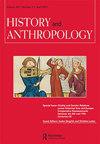Charting a Malay-Islamic past: An emerging transnational geography of meaning and the consolidation of an exclusivist identity in Malaysia
IF 0.4
2区 历史学
Q3 ANTHROPOLOGY
引用次数: 0
Abstract
ABSTRACTThis article examines an emerging historical narrative that invokes an exclusivist Malay-Islamic identity in Malaysia through a sacred geography centred on Aceh in Indonesia. The examination is located against the growing sacralisation of space across the world and its often contentious if not violent political outcomes. It considers the role of scholarship on sacred geographies in the face of output on the same subject by an informal expert – a person working outside of established institutional frameworks. The article focuses on the writings of Radzi Sapiee, a Malaysian informal expert who advances an exclusivist Malay-Islamic identity based on field observations, scholarly works, and inner wisdom. His partially completed book series constitutes an autobiographical return to Aceh and articulates a transnational geography of meaning that consolidates the exclusivist identity within the already racialised politics of Malaysia by further grounding it in space and time.KEYWORDS: Geography of meaningexclusivist Malay-Islamic identityinformal expertscholarship on sacred geographiesAcehMalaysiakeramat (Muslim gravesite-shrine) AcknowledgementsThis article grew out of a fellowship and workshop at the Royal Netherlands Institute of Southeast Asian and Caribbean Studies (KITLV) in Leiden, the Netherlands, in August and September 2017, and the conversations and unstinting support of Marieke Bloembergen and David Kloos. The second part of the article includes in much revised form a paper delivered at the workshop ‘Circulating the Bay of Bengal, Miraculously: Translating Wonder and Travel in Southeast Asia’ organized by the Nalanda-Sriwijaya Centre in Singapore in February 2017. I am grateful to Teren Sevea for inviting me to this meeting and his unfailing encouragement. I thank Dag Yngvesson for his careful reading and detailed comments of a draft and two anonymous reviewers whose insights helped to better frame and contextualize the argument.Disclosure statementNo potential conflict of interest was reported by the author(s).Notes1 ‘Sesi bicara di DBP – Mengenali Kepustakaan Ali Hasjmy,’ http://merahsilu.blogspot.com/2019/02/bicara-di-dbp-mengenali-kepustakaan-ali.html.2 The blog is titled ‘Catatan Si Merah Silu [Notes of Merah Silu]’ and can be accessed through the following URL: http://merahsilu.blogspot.com/.3 Thailand is the only country in this list that was not colonized.4 These were Monash University Malaysia, University College Sedaya International, Universiti Kebangsaan Malaysia (National University of Malaysia), and the University of Oxford.5 The Hikayat Mareskalek (Story of Mareskalek) written by Abdullah al-Misri in the early nineteenth century tells of a European governor-general who in a fit of vanity took the title Susuhunan, an honorific used to address the nine saints who are said to have converted Java’s population to Islam. He is haunted by a visit in his dreams by one of the said saints and decides, as a result, to make penance by going on a ritual pilgrimage to the gravesite shrines of each one of them.6 I focus on Muslims in this article but keramat have been known to draw people of diverse faiths.描绘马来-伊斯兰的过去:一个新兴的跨国地理意义和马来西亚排他性身份的巩固
摘要本文探讨了一种新兴的历史叙事,通过以印度尼西亚亚齐为中心的神圣地理,在马来西亚唤起了一种排他的马来-伊斯兰身份。这项研究的背景是世界范围内日益增长的太空神圣化,以及它经常引起争议(如果不是暴力的话)的政治结果。它考虑了在一个非正式专家——一个在既定体制框架之外工作的人——就同一主题发表的成果面前,关于神圣地理的学术研究的作用。本文聚焦于马来西亚非正式专家Radzi Sapiee的著作,他基于实地观察、学术著作和内心智慧,提出了一种排外的马来-伊斯兰身份认同。他部分完成的系列书籍构成了对亚齐的自传式回归,并阐明了一种跨国地理的意义,通过进一步在空间和时间上扎根,巩固了马来西亚已经种族化的政治中的排他性身份。本文源于2017年8月和9月在荷兰莱顿的荷兰皇家东南亚和加勒比研究所(KITLV)举办的一个奖学金和研讨会,以及Marieke Bloembergen和David Kloos的对话和慷慨支持。文章的第二部分包含了一篇在2017年2月新加坡那烂陀-斯里维加亚中心举办的研讨会上发表的论文,该研讨会的主题是“奇迹般地循环孟加拉湾:翻译东南亚的奇迹和旅行”。我感谢Teren Sevea邀请我参加这次会议,并一直给予鼓励。我要感谢Dag Yngvesson对一份草稿的仔细阅读和详细评论,以及两位匿名审稿人,他们的见解有助于更好地构建和背景化论点。披露声明作者未报告潜在的利益冲突。注1“Sesi bicara di DBP - Mengenali Kepustakaan Ali Hasjmy”http://merahsilu.blogspot.com/2019/02/bicara-di-dbp-mengenali-kepustakaan-ali.html.2该博客题为“Catatan Si Merah Silu”,可透过以下网址浏览:http://merahsilu.blogspot.com/.3泰国是此名单中唯一未被殖民的国家这些大学分别是马来西亚莫纳什大学、塞达亚国际大学学院、马来西亚国立大学和牛津大学。阿卜杜拉·米斯里在19世纪早期写的《马列斯卡莱克的故事》(Hikayat Mareskalek)讲述了一位欧洲总督出于虚荣,取了苏苏南(Susuhunan)的头衔,这是对九位据说使爪哇人口皈依伊斯兰教的圣人的尊称。他在梦中被其中一位圣人的来访所困扰,因此,他决定去每位圣人的墓地朝圣,以此来赎罪我在这篇文章中主要关注穆斯林,但众所周知,keramat吸引了不同信仰的人。
本文章由计算机程序翻译,如有差异,请以英文原文为准。
求助全文
约1分钟内获得全文
求助全文
来源期刊

History and Anthropology
Multiple-
CiteScore
1.80
自引率
0.00%
发文量
41
期刊介绍:
History and Anthropology continues to address the intersection of history and social sciences, focusing on the interchange between anthropologically-informed history, historically-informed anthropology and the history of ethnographic and anthropological representation. It is now widely perceived that the formerly dominant ahistorical perspectives within anthropology severely restricted interpretation and analysis. Much recent work has therefore been concerned with social change and colonial history and the traditional problems such as symbolism, have been rethought in historical terms. History and Anthropology publishes articles which develop these concerns, and is particularly interested in linking new substantive analyses with critical perspectives on anthropological discourse.
 求助内容:
求助内容: 应助结果提醒方式:
应助结果提醒方式:


